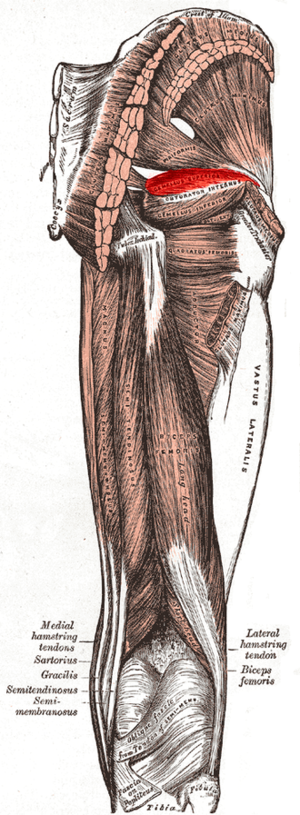Gemellus Superior: Difference between revisions
Abbey Wright (talk | contribs) No edit summary |
Abbey Wright (talk | contribs) (content edit) |
||
| Line 5: | Line 5: | ||
</div> | </div> | ||
== Description == | == Description == | ||
Gemellus superior is a small muscle in the posterio-latereal portion of the [[hip]]. It works with [[Gemellus Inferior|gemellus inferior]] and [[Obturator Internus|obturator internus]], to form the triceps coxae, to externally rotate | Gemellus superior is a small muscle in the posterio-latereal portion of the [[hip]]. It works with [[Gemellus Inferior|gemellus inferior]] and [[Obturator Internus|obturator internus]], to form the triceps coxae, to externally rotate the hip<ref>Palastanga, NIgel; Soames, Roger (November 2011). ''Physiotherapy Essentials : Anatomy and Human Movement : Structure and Function'' (6th ed.). London, GBR: Elsevier Health Sciences. p. 235</ref>. These three muscles also act as the deep stabilisers of the hip.<ref>Brukner, Peter. (2011). ''Brukner & Kahn's Clinical Sports Medicine (4th Edition).'' Australia. McGraw-Hill education Pty Ltd. p514-515 </ref> [[File:Gemellus superior.png|thumb]] | ||
=== Origin === | === Origin === | ||
| Line 14: | Line 14: | ||
=== Nerve === | === Nerve === | ||
L5, S1, and S2 | Nerve to obturator internus, which is formed from portions of the L5, S1, and S2 spinal nerves. | ||
=== Artery === | === Artery === | ||
Inferior gluteal and internal pudendal arteries | |||
== Function == | == Function == | ||
The gemelli muscles act to externally (laterally) rotate | The gemelli muscles act to externally (laterally) rotate the hip. | ||
{{#ev:youtube|v=SWuoa-XJPXg}}<ref>Kenhub - Learn human anatomy. Functions of the gemelli muscles (preview) - 3D Human Anatomy | Kenhub. Available from: https://www.youtube.com/watch?v=SWuoa-XJPXg [last accessed 25/07/2019]</ref> | {{#ev:youtube|v=SWuoa-XJPXg}}<ref>Kenhub - Learn human anatomy. Functions of the gemelli muscles (preview) - 3D Human Anatomy | Kenhub. Available from: https://www.youtube.com/watch?v=SWuoa-XJPXg [last accessed 25/07/2019]</ref> | ||
== Clinical relevance == | == Clinical relevance == | ||
Together with its twin: gemellus inferior as well as obturator internus and [[piriformis]], gemellus superior is a deep stabiliser of the hip joint. These four muscles work with [[Gluteus Maximus|gluteus maximus]] to resist anterior forces of the hip. <ref>Brukner, Peter. (2011). ''Brukner & Kahn's Clinical Sports Medicine (4th Edition).'' Australia. McGraw-Hill education Pty Ltd. p516</ref> | |||
It is difficult to assess gemellus superior in isolation due to its proximity to the other external rotators of the hip. Testing of the external rotators would be done in a normal [[Hip Examination|hip assessment]]. | |||
== Resources == | == Resources == | ||
Revision as of 13:56, 24 January 2020
Original Editor -
Top Contributors - Abbey Wright
Description[edit | edit source]
Gemellus superior is a small muscle in the posterio-latereal portion of the hip. It works with gemellus inferior and obturator internus, to form the triceps coxae, to externally rotate the hip[1]. These three muscles also act as the deep stabilisers of the hip.[2]
Origin[edit | edit source]
Gemellus superior originates from the outer (gluteal) surface of the spine of the ischium[3]
Insertion[edit | edit source]
It has a blended insertion with the upper part of the tendon of the Obturator internus.[3]
Nerve[edit | edit source]
Nerve to obturator internus, which is formed from portions of the L5, S1, and S2 spinal nerves.
Artery[edit | edit source]
Inferior gluteal and internal pudendal arteries
Function[edit | edit source]
The gemelli muscles act to externally (laterally) rotate the hip.
Clinical relevance[edit | edit source]
Together with its twin: gemellus inferior as well as obturator internus and piriformis, gemellus superior is a deep stabiliser of the hip joint. These four muscles work with gluteus maximus to resist anterior forces of the hip. [5]
It is difficult to assess gemellus superior in isolation due to its proximity to the other external rotators of the hip. Testing of the external rotators would be done in a normal hip assessment.
Resources[edit | edit source]
- ↑ Palastanga, NIgel; Soames, Roger (November 2011). Physiotherapy Essentials : Anatomy and Human Movement : Structure and Function (6th ed.). London, GBR: Elsevier Health Sciences. p. 235
- ↑ Brukner, Peter. (2011). Brukner & Kahn's Clinical Sports Medicine (4th Edition). Australia. McGraw-Hill education Pty Ltd. p514-515
- ↑ 3.0 3.1 Palastanga, NIgel; Soames, Roger (November 2011). Physiotherapy Essentials : Anatomy and Human Movement : Structure and Function (6th ed.). London, GBR: Elsevier Health Sciences. p. 237.
- ↑ Kenhub - Learn human anatomy. Functions of the gemelli muscles (preview) - 3D Human Anatomy | Kenhub. Available from: https://www.youtube.com/watch?v=SWuoa-XJPXg [last accessed 25/07/2019]
- ↑ Brukner, Peter. (2011). Brukner & Kahn's Clinical Sports Medicine (4th Edition). Australia. McGraw-Hill education Pty Ltd. p516







